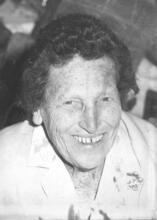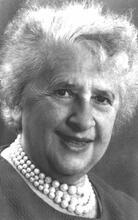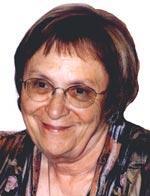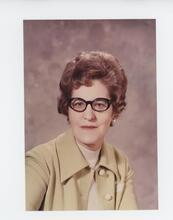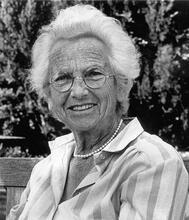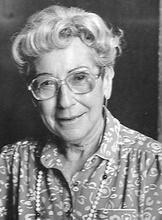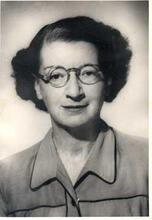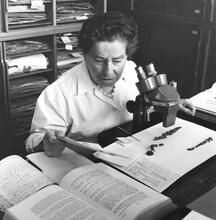Ida Henrietta Hyde
Ida Henrietta Hyde is best known for creating a microelectrode that could sample and manipulate individual cells. She earned a degree from Cornell in 1891, did graduate work at Bryn Mawr, and studied at the Woods Hole Marine Biological Laboratory in the summer. In 1893 she received a fellowship from what would become the American Association of University Women to earn her PhD at the University of Heidelberg and study at the Zoological Station in Naples, Italy. In 1897 she founded the Naples Table Association for Promoting Scientific Research by Women. In 1899 she founded the physiology department at the University of Kansas in Lawrence. She later retired to California to continue her cutting-edge research on the effects of caffeine and alcohol.
Physiologist Ida Henrietta Hyde’s proudest accomplishment wasn’t her pioneering research—it was her work on behalf of other women scientists. In 1896, she conducted research at the Zoological Station in Naples, Italy, after completing her Ph.D. in Heidelberg, Germany. The next year, she persuaded America’s foremost women educators and philanthropists to make this opportunity available to other American women scientists. The group she founded was known as the Naples Table Association for Promoting Scientific Research by Women. Using a subscription system, the group raised five hundred dollars annually to fund a research “table,” actually a small laboratory, where thirty-six American women in all benefited from Hyde’s vision.
Early Life and Education
Ida Hyde was born on September 8, 1857. Her parents, Meyer H. and Babette (Loewenthal) Heidenheimer, had emigrated from Germany before she was born, anglicizing the family name to Hyde. Hyde’s mother ran a prosperous store until it burned in the Chicago fire of 1871. This abrupt change in the family finances forced Hyde to leave school. At age sixteen, when she apprenticed at the millinery establishment, she was living in a female-headed household consisting of her mother, a younger brother Ben, and two sisters, Clara and Sophie. Her sister Tillie had already married. While working six days a week, Hyde attended evening classes at the Chicago Athenaeum.
Hyde’s family valued education for sons but not for daughters. At twenty-four, Hyde used all her savings for one year of college. She took and passed the county teachers’ exam and, three years later, the Chicago teachers’ exam. One year she attended a summer school for teachers at Martha’s Vineyard, an experience that provided the catalyst she needed to become a scientist. Although she taught several more years, her entire attention was riveted on attaining a college degree in science.
In 1889, Hyde left Chicago to attend Cornell University, graduating in 1891. Giving up her initial plan to attend medical school, she instead accepted a graduate fellowship at Bryn Mawr, where she worked with such major scientists as T. H. Morgan and Jacques Loeb. Her summers were spent at Woods Hole Marine Biological Laboratory in Massachusetts. In 1893, she received an Association of Collegiate Alumnae fellowship to study in Europe. This organization of women college graduates is known today as the American Association of University Women (AAUW).
Career and Legacy
Hyde’s doctorate was problematic because she chose to combine a zoological thesis with physiology, a discipline in medical school where women were not welcome. She finally received her doctorate in 1894, at age thirty-seven. But the difficulties she overcame led to invitations—to do research first at the Zoological Station in Italy and later at the Harvard Medical School, while she supported herself by teaching science at private girls’ schools and took a few medical courses. During this time in Boston, Hyde founded the Naples Table Association and served as its first secretary for several years.
In 1899, Hyde was hired to found a physiology department at the University of Kansas in Lawrence—a remarkable accomplishment, because it was a very rare occurrence for a woman to be hired as a professor at a coeducational college. A popular teacher, Hyde drew on her European and Harvard experiences to have state-of-the-art facilities constructed. During summer vacations, she continued her medical education, spending three summers at Rush Medical School in Chicago. Her request for a leave of absence to complete her residency was denied. In 1916, the leadership of her department changed to a committee form, and she was eventually forced out. Her religion (Society for Ethical Culture) and lack of an M.D. may have been factors, but mainly her colleagues wanted a man in her position. Finally, in 1918, she took a leave of absence for wartime duties and never returned to the University of Kansas. For three years, she traveled around the world, studying women’s education as a representative of the AAUW. She retired in California and continued to do research.
On August 22, 1945, at age eighty-eight, Ida Henrietta Hyde died of a cerebral hemorrhage. She is buried in the cemetery at Woods Hole, Massachusetts.
Hyde’s research spanned work on the nervous, circulatory, and respiratory systems. She also invented a microelectrode. Her research on the effects of alcohol, caffeine, and narcotics was decades ahead of its time. The merit of her research is evident: In 1902, the American Society of Physiologists elected her its first woman member.
Selected Works
“Before Women Were Human Beings …” AAUW Journal 31, 4 (1938): 226–236.
“The Kaiser and the Devilfish.” The New York Evening Post Magazine, May 25, 1918.
Hyde, Ida Henrietta. Papers. American Association of University Women Archives, Washington, D.C., and University Archives. University of Kansas, Lawrence.
Johnson, Elsie Ernest. “Ida Henrietta Hyde: Early Experiments.” The Physiologist 24, no. 6 (1981): 10–11.
Jones, T. Sydney. “Ida H. Hyde.” Notable Twentieth-Century Scientists (1995): 988–990.
NAW; Sloan, Jan Butin. “The Founding of the Naples Table Association for Promoting Scientific Research by Women, 1897.” SIGNS: Journal of Women in Culture and Society (1978): 208–216.
Tucker, Gail S. “Ida Henrietta Hyde: The First Woman Member of the Society.” The Physiologist 24, no. 6 (1981): 1–9.
Wittig, Gertraude. “Hyde’s 1896 German Doctorate: Opening Science to Women.” Unpublished paper.

